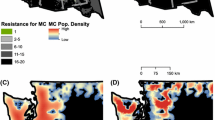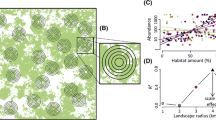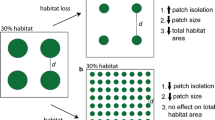Abstract
The spatial extent at which landscape structure best predicts population response, called the scale of effect, varies across species. An ability to predict the scale of effect of a landscape using species traits would make landscape study design more efficient and would enable landscape managers to plan at the appropriate scale. We used an individual based simulation model to predict how species traits influence the scale of effect. Specifically, we tested the effects of dispersal distance, reproductive rate, and informed movement behavior on the radius at which percent habitat cover best predicts population abundance in a focal area. Scale of effect for species with random movement behavior was compared to scale of effect for species with three (cumulative) levels of information use during dispersal: habitat based settlement, conspecific density based settlement, and gap-avoidance during movement. Consistent with a common belief among researchers, dispersal distance had a strong, positive influence on scale of effect. A general guideline for empiricists is to expect the radius of a landscape to be 4–9 times the median dispersal distance or 0.3–0.5 times the maximum dispersal distance of a species. Informed dispersal led to greater increases in population size than did increased reproductive rate. Similarly, informed dispersal led to more strongly decreased scales of effect than did reproductive rate. Most notably, gap-avoidance resulted in scales that were 0.2–0.5 times those of non-avoidant species. This is the first study to generate testable hypotheses concerning the mechanisms underlying the scale at which populations respond to the landscape.




Similar content being viewed by others
References
Akçakaya HR (1991) A method for simulating demographic stochasticity. Ecol Model 54:133–136
Baguette M, Van Dyck H (2007) Landscape connectivity and animal behavior: functional grain as a key determinant for dispersal. Landscape Ecol 22:1117–1129
Barton KA, Phillips BL, Morales JM, Travis JMJ (2009) The evolution of an ‘intelligent’ dispersal strategy: biased, correlated random walks in patchy landscapes. Oikos 118:309–319
Bowler DE, Benton TG (2005) Causes and consequences of animal dispersal strategies: relating individual behaviour to spatial dynamics. Biol Rev 80:205–225
Bowman J (2003) Is dispersal distance of birds proportional to territory size? Can J Zool 81:195–202
Bowman J, Jaeger JAG, Fahrig L (2002) Dispersal distance of mammals proportional to home range size. Ecology 83:2049–2055
Brennan JM, Bender DJ, Contreras TA, Fahrig L (2002) Focal patch landscape studies for wildlife management: optimizing sampling effort across scales. In: Liu J, Taylor WW (eds) Integrating landscape ecology into natural resource management. Cambridge University Press, Cambridge
Burnham KP, Anderson DR (2002) Model selection and inference: a practical information-theoretic approach. Springer, New York
Carr LW, Fahrig L (2001) Effect of road traffic on two amphibian species of differing vagility. Conserv Biol 15:1071–1078
Chapman DS, Dytham C, Oxford GS (2007) Modelling population redistribution in a leaf beetle: an evaluation of alternative dispersal functions. J Anim Ecol 76:36–44
Clobert J, Galliard J-FL, Cote J, Meylan S, Massot M (2009) Informed dispersal, heterogeneity in animal dispersal syndromes and the dynamics of spatially structured populations. Ecol Lett 12:197–209
Eigenbrod F, Hecnar SJ, Fahrig L (2008) The relative effects of road traffic and forest cover on anuran populations. Biol Conserv 141:35–46
Fagan WF, Lynch HJ, Noon BR (2010) Pitfalls and challenges of estimating population growth rate from empirical data: consequences for allometric scaling relations. Oikos 119:455–464
Fahrig L (2001) How much habitat is enough? Biol Conserv 100:65–74
Fahrig L (2003) Effects of habitat fragmentation on biodiversity. Annu Rev Ecol Evol Syst 34:487–515
Fletcher RJ (2006) Emergent properties of conspecific attraction in fragmented landscapes. Am Nat 168:207–219
Guo YL, Ge S (2005) Molecular phylogeny of Oryzeae (Poaceae) based on DNA sequences from chloroplast, mitochondrial, and nuclear genomes. Am J Bot 92:1548–1558
Hawkes C (2009) Linking movement behaviour, dispersal and population processes: is individual variation a key? J Anim Ecol 78:894–906
Holland JD, Fahrig L, Cappuccino N (2005a) Body size affects the spatial scale of habitat–beetle interactions. Oikos 110:101–108
Holland JD, Fahrig L, Cappuccino N (2005b) Fecundity determines the extinction threshold in a Canadian assemblage of longhorned beetles (Coleoptera: Cerambycidae). J Insect Conserv 9:109–119
Holling CS (1992) Cross-scale morphology, geometry, and dynamics of ecosystems. Ecol Monogr 62:447–502
Horner-Devine MC, Daily GC, Ehrlich PR, Boggs CL (2003) Countryside biogeography of tropical butterflies. Conserv Biol 17:168–177
Jackson HB, Baum K, Robert T, Cronin JT (2009) Habitat-specific and edge-mediated dispersal behavior of a saproxylic insect, Odontotaenius disjunctus Illiger (Coleoptera: Passalidae). Environ Entomol 38:1411–1422
Jetz W, Carbone C, Fulford J, Brown JH (2004) The scaling of animal space use. Science 306:266–268
Kareiva PM, Shigesada N (1983) Analyzing insect movement as a correlated random-walk. Oecologia 56:234–238
Kot M, Lewis MA, van den Driessche P (1996) Dispersal data and the spread of invading organisms. Ecology 77:2027–2042
Laurance WF, Lovejoy TE, Vasconcelos HL, Bruna EM, Didham RK, Stouffer PC, Gascon C, Bierregaard RO, Laurance SG, Sampaio E (2002) Ecosystem decay of Amazonian forest fragments: a 22-year investigation. Conserv Biol 16:605–618
Nichols RA, Hewitt GM (1994) The genetic consequences of long-distance dispersal during colonization. Heredity 72:312–317
Okubo A (1980) Diffusion and ecological problems: mathematical models. Springer, New York
Ricketts TH, Daily GC, Ehrlich PR, Fay JP (2001) Countryside biogeography of moths in a fragmented landscape: biodiversity in native and agricultural habitats. Conserv Biol 15:378–388
Ries L, Debinski DM (2001) Butterfly responses to habitat edges in the highly fragmented prairies of central Iowa. J Anim Ecol 70:840–852
Ritchie ME (2010) Scale, heterogeneity, and the structure and diversity of ecological communities. Princeton University Press, Princeton
Roland J, Taylor PD (1997) Insect parasitoid species respond to forest structure at different spatial scales. Nature 386:710–713
Saupe D (1988) Algorithms for random fractals. In: Peitgen H-O, Saupe D (eds) The science of fractal images. Springer, New York, pp 71–113
Schultz CB, Crone EE (2001) Edge-mediated dispersal behavior in a prairie butterfly. Ecology 82:1879–1892
Smith AC, Fahrig L, Francis CM (2011) Landscape size affects the relative importance of habitat amount, habitat fragmentation, and matrix quality on forest birds. Ecography 34:103–113
Tischendorf L, Grez A, Zaviezo T, Fahrig L (2005) Mechanisms affecting population density in fragmented habitat. Ecol Soc 10:13
Tittler R (2008) Source–sink dynamics, dispersal, and landscape effects on North American songbirds. Dissertation, Carleton University, Ottawa
Turchin P (1998) Quantitative analysis of movement: measuring and modeling population redistribution in animals and plants. Sinauer Associates, Inc., Sunderland
Vance MD, Fahrig L, Flather CH (2003) Effect of reproductive rate on minimum habitat requirements of forest-breeding birds. Ecology 84:2643–2653
Wilensky U (1999) Netlogo. http://ccl.northwestern.edu/netlogo/. Center for Connected Learning and Computer-Based Modeling, Northwestern University, Evanston
With KA, King AW (1999) Extinction thresholds for species in fractal landscapes. Conserv Biol 13:314–326
Zollner PA, Lima SL (1999) Search strategies for landscape-level interpatch movements. Ecology 80:1019–1030
Acknowledgments
We thank Lutz Tischendorf for his modelling suggestions and for his assistance with NetLogo. This work was supported by Natural Sciences and Engineering Research Council of Canada (NSERC) grants to LF. We thank Nathan Jackson and three anonymous reviewers for their helpful suggestions.
Author information
Authors and Affiliations
Corresponding author
Electronic supplementary material
Below is the link to the electronic supplementary material.
Rights and permissions
About this article
Cite this article
Jackson, H.B., Fahrig, L. What size is a biologically relevant landscape?. Landscape Ecol 27, 929–941 (2012). https://doi.org/10.1007/s10980-012-9757-9
Received:
Accepted:
Published:
Issue Date:
DOI: https://doi.org/10.1007/s10980-012-9757-9




